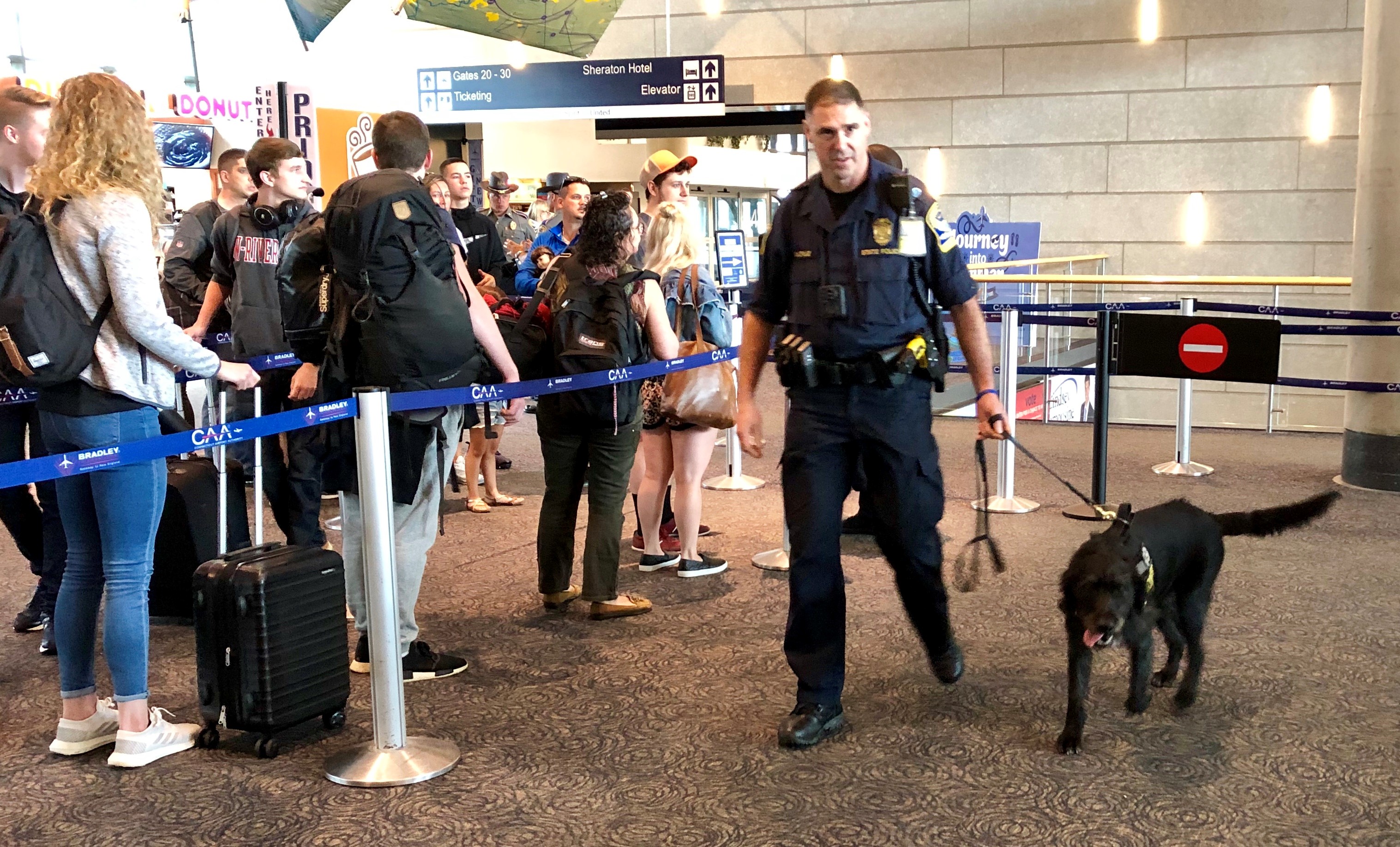 A Connecticut State Police trooper and his TSA passenger screening canine working at the Bradley International Airport checkpoint line. (TSA photo)
A Connecticut State Police trooper and his TSA passenger screening canine working at the Bradley International Airport checkpoint line. (TSA photo)
WINDSOR LOCKS, Conn. – The Connecticut State Police has teamed up with the Transportation Security Administration to place several passenger screening canine teams at Bradley International Airport, serving as a key asset to enhance airport security and keep passengers safe and secure.
The canine handlers are Connecticut State Police troopers who were trained along with their canine partners at TSA’s National Canine Training Center in San Antonio, Texas. The dogs were trained for 12 weeks as they learned to detect explosive materials in the busy transportation environment. The dogs sniff the air currents surrounding travelers and their belongings as they pass through the airport terminal and checkpoints in an effort to detect anyone who may be carrying explosives. Because they work among passengers to determine if they have any explosives on them, the dogs are known as passenger screening canines. The canine teams assist with the efficiency and effectiveness of TSA’s screening operations at the checkpoints.
Passenger screening canines and their handlers are an important layer of airport security because they increase TSA’s explosive detection capability. The procedures involve a reconfiguration of checkpoint lines to allow for the passengers to walk past the dogs. This added screening measure enhances security and allows TSA to better detect threats.
“Previously, TSA only trained its own employees to serve as passenger screening canine handlers working in and around checkpoints, and this new level of partnering with the Connecticut State Police is a model for how TSA can improve upon its current relationship with local law enforcement to boost airport security,” explained William Csontos, TSA’s federal security director for Connecticut. “Prior to this new level of collaboration, TSA would train law enforcement officers and dogs to be traditional explosives detection canines, but now they are being trained as passenger screening canines to assist in checkpoint screening of travelers. It’s an exciting collaboration with the State Police.”
Passengers departing Bradley International Airport can, at any time, expect to see the State Police canine teams working around travelers.
“The teams skillfully navigate among large groups of people to pinpoint the source of an explosive odor, even if the source is mobile and often without the source being aware it is being tracked,” Csontos said. The canine handlers are trained to read their dog’s change of behavior when it indicates an explosive odor has been detected.
“The partnership between the Connecticut State Police and TSA has not only provided a higher level of security, but also has allowed the airport screening process to become more efficient. Troopers with their passenger screening canines are working at the heaviest travel times of the day, which moves travelers through the checkpoint faster,” said Colonel Stavros Mellekas, the commanding officer of the Connecticut State Police. “These canine teams will ensure that passenger safety remains the top priority at Bradley. We are thankful to TSA to allow us to be part of their team and we are excited about the expansion of the TSA canine program.”
If a dog alerts its handler to the presence of explosive odor, the Troopers follow an established procedure to resolve the alarm. The use of these highly trained canines is an effective tool in deterring and detecting the introduction of explosive devices into the nation’s transportation systems.
Because explosives are known to be the greatest threat to the aviation system, the canines train regularly to ensure they maintain a high standard of operational effectiveness. This continual training allows for all teams to be a reliable resource in detecting an explosive threat, maintaining proper acclimation within the airport, and mitigating potential distractions in a busy transportation environment.
